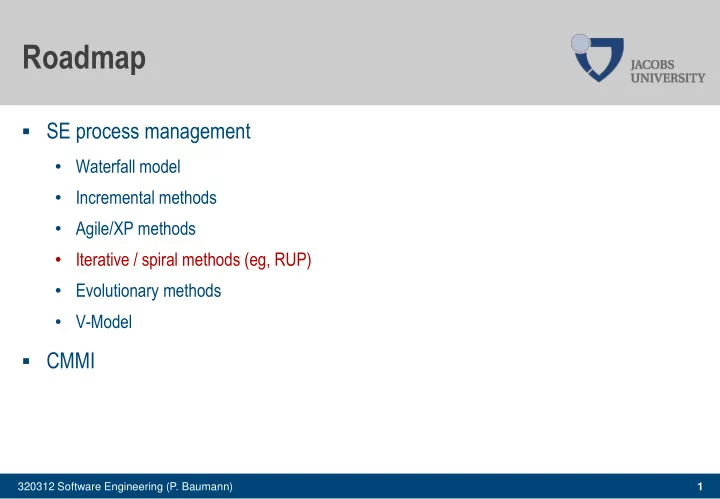

Roadmap SE process management • Waterfall model • Incremental methods • Agile/XP methods • Iterative / spiral methods (eg, RUP) • Evolutionary methods • V-Model CMMI 320312 Software Engineering (P. Baumann) 1
Spiral Model Objective setting • Identify objectives for this phase risk assessment objective & reduction Risk assessment & reduction • Risks assessed • activities to reduce key risks Development & validation start • Choose any development model development validation Planning deployment feedback • Review prototype 1 planning prototype 2 • Plan next spiral phase prototype n 320312 Software Engineering (P. Baumann) 2
Spiral Model: The Rules Process is spiral rather than sequence with backtracking loop in spiral = one phase in the process No fixed phases • …such as specification or design • loops in spiral chosen depending on what is required Risks explicitly assessed & resolved throughout the process Probably suitable for small/medium size high-risk, high-change projects 320312 Software Engineering (P. Baumann) 3
[Rational] Unified Process (RUP) Model Software process based on Unified Modeling Language (UML) • use-case driven …supports req -to-spec transition • architecture-centric …supports factorization/modularization • iterative and incremental …supports project management Normally described from 3 perspectives: • dynamic perspective: phases over time • static perspective: process activities • practice perspective: suggests good practice 320312 Software Engineering (P. Baumann) 4
UP Phases Inception • Establish business case Elaboration elaboration construction • understanding of problem domain & system architecture inception Construction transition • System design, programming, testing production Transition • Deploy system in operative Release environment Software increment Production • Support & maintain 320312 Software Engineering (P. Baumann) 5
UP Phases phases: inception elaboration construction transition production Workflows: Requirements Analysis Design Implementation Test Support Iterations #1 #2 #n-1 #n 320312 Software Engineering (P. Baumann) 6
UP Key Points Rational Unified Process: increased flexibility by combining • generic process model • incremental ideas • evolutionary ideas (prototyping! see next) Core characteristic: separates activities from phases 320312 Software Engineering (P. Baumann) 10
Evolutionary Development Exploratory development • work with customers • evolve final system from initial outline specification • start with well-understood requirements, add new features as proposed by customer similar to incremental / iterative approach Throw-away prototyping • Goal: understand system requirements, not to build a deliverable • start with poorly understood requirements to clarify what is really needed 320312 Software Engineering (P. Baumann) 12
Prototyping For some large systems, incremental development & delivery may be impractical • especially true when multiple teams working on different sites Alternative: Prototyping • experimental system developed as basis for formulating requirements • thrown away when system specification agreed prototype = initial version of a system used to • demonstrate concepts try out design options • prototype can be used in: • requirements engineering process help with requirements elicitation & validation • design processes explore options, develop UI design • testing process run back-to-back tests 320312 Software Engineering (P. Baumann) 13
Back-to-Back Testing Test data System Application prototype system Results comparator Difference report 320312 Software Engineering (P. Baumann) 14
Throw-Away Prototypes Prototypes should be discarded after development as they are not a good basis for a production system: • may be impossible to tune the system to meet non-functional requirements • Prototypes normally undocumented • prototype structure usually degraded through rapid change • prototype probably will not meet normal organisational quality standards 320312 Software Engineering (P. Baumann) 15
When Incremental Dev, When Prototype? incremental development : deliver working system to end-users • development starts with requirements best understood throw-away prototyping: validate or derive system requirements • prototyping process starts with requirements poorly understood 320312 Software Engineering (P. Baumann) 16
Evolutionary Development: Appraisal Problems • Lack of process visibility • Systems are often poorly structured • Special skills (e.g. in languages for rapid prototyping) may be required Applicability • For small or medium-size interactive systems • For well isolated parts of large systems (e.g. the user interface) • For short-lifetime systems 320312 Software Engineering (P. Baumann) 17
Roadmap SE process management • Waterfall model • Incremental methods • Agile/XP methods • Iterative / spiral methods (eg, RUP) • Evolutionary methods • V-Model CMMI 320312 Software Engineering (P. Baumann) 18
Vorgehens-Modell = Development Standard for IT Systems of the Federal Republic of Germany • German national standard, mandatory for gov (and sometimes industry) procured projects • Status: V-Model XT (Feb 2005), see www.v-modell-xt.de features • process model for planning and realizing development projects • considering entire system (!) life cycle • responsibilities of each participant ("who" has to do "what" and "when") • ...rather detailed Classification: waterfall++, " can be mapped to UP " 320312 Software Engineering (P. Baumann) 19
Recommend
More recommend